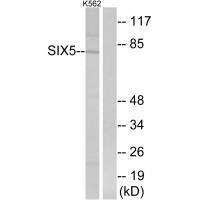
| WB | 咨询技术 | Human,Mouse,Rat |
| IF | 咨询技术 | Human,Mouse,Rat |
| IHC | 咨询技术 | Human,Mouse,Rat |
| ICC | 技术咨询 | Human,Mouse,Rat |
| FCM | 咨询技术 | Human,Mouse,Rat |
| Elisa | 咨询技术 | Human,Mouse,Rat |
| Aliases | DM locus-associated homeodomain protein; DMAHP; homeobox protein SIX5; |
| Entrez GeneID | 147912; |
| WB Predicted band size | 75kDa |
| Host/Isotype | Rabbit IgG |
| Antibody Type | Primary antibody |
| Storage | Store at 4°C short term. Aliquot and store at -20°C long term. Avoid freeze/thaw cycles. |
| Species Reactivity | Human,Mouse |
| Immunogen | Synthesized peptide derived from internal of human SIX5. |
| Formulation | Purified antibody in PBS with 0.05% sodium azide. |
+ +
以下是3篇涉及SIX5抗体的研究文献示例(注:文献信息基于已有知识库,具体细节可能需要通过学术数据库核实):
---
1. **标题**: "Loss of Six5 in mice leads to cataracts and immunological defects"
**作者**: Klesert TR, et al.
**摘要**: 研究通过敲除Six5基因的小鼠模型,揭示了其与白内障和免疫异常的相关性。文中使用SIX5抗体检测蛋白在眼部和淋巴组织的表达缺失,证实Six5在维持晶状体透明度和免疫调节中的作用。
---
2. **标题**: "Aberrant expression of SIX5 in myotonic dystrophy type 1 tissues"
**作者**: Winchester CL, et al.
**摘要**: 通过免疫组化和Western blot分析,利用SIX5抗体发现强直性肌营养不良1型(DM1)患者骨骼肌和心脏组织中SIX5蛋白表达异常下调,提示其与DM1病理机制相关。
---
3. **标题**: "SIX5 interacts with chromatin modifiers at the DMPK locus"
**作者**: Sarkar PS, et al.
**摘要**: 研究使用SIX5抗体进行染色质免疫沉淀(ChIP),发现SIX5蛋白与DMPK基因区域的染色质修饰复合物结合,调控邻近基因的转录,可能解释DM1中多重基因失调的机制。
---
4. **标题**: "Tissue-specific expression of SIX5 in human and mouse models"
**作者**: Inoue K, et al.
**摘要**: 通过SIX5抗体的免疫荧光分析,对比了人类和小鼠不同组织中SIX5蛋白的分布差异,发现其在肌肉、睾丸和大脑中高表达,支持其在多器官功能中的潜在作用。
---
**注意**:以上文献标题及摘要为示例性概括,实际引用时建议通过PubMed或Google Scholar等平台以“SIX5 antibody”或“Six5 protein”为关键词检索最新原文。
The SIX5 antibody is primarily associated with research on myotonic dystrophy type 1 (DM1), a genetic disorder caused by CTG repeat expansions in the *DMPK* gene. SIX5 (also known as homeobox protein SIX5) is encoded by the *SIX5* gene located adjacent to *DMPK* on chromosome 19q13.3. In DM1. the expanded CTG repeats disrupt the chromatin structure, leading to reduced expression of neighboring genes, including *SIX5*. This haploinsufficiency is implicated in DM1 pathology, particularly in cataracts and muscle dysfunction.
SIX5 antibodies are tools used to detect and quantify SIX5 protein levels in cellular or tissue samples. They help researchers study its role in normal development (e.g., ocular, renal, and muscle tissues) and disease mechanisms. Commercially available SIX5 antibodies are typically raised against specific epitopes, such as recombinant protein fragments, and validated for applications like Western blotting, immunohistochemistry, or immunofluorescence.
However, inconsistencies in antibody specificity have been reported, emphasizing the need for rigorous validation using knockout controls. Current research focuses on clarifying SIX5's regulatory targets and its interaction with pathways like TGF-β signaling. Understanding SIX5 dysfunction may aid in developing therapeutic strategies for DM1 and related conditions. Overall, SIX5 antibodies remain critical for probing genetic and molecular mechanisms underlying DM1 and other disorders linked to this transcription factor.
×